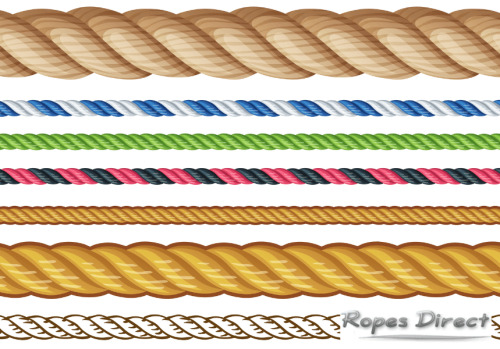Not sure which rope to buy?
Many of our customers have the same dilemma. After all, there are so many different types of rope available. Choosing the best one for your needs can feel like a bit of a puzzle.
The key to success is to select the right rope material for the job.
Classified as either ‘natural’ or ‘synthetic’, each material has different properties – making it more or less suited to a particular application. Some are better for indoor use. Others are better for the outdoors. Some are stronger and more durable. Others are softer to touch etc.
To help with your decision, here we’ve created a quick guide – with a summary of the most popular rope materials and the jobs and projects they’re best suited for. So before you add anything to your basket, why not take a look? And make doubly sure you’re on the right track.
7 popular rope materials
Cotton Ropes
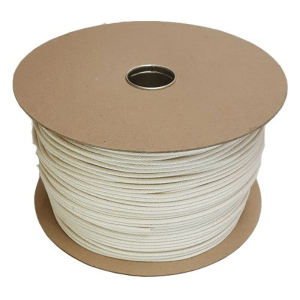
Derived from the seed of the cotton plant, cotton is a natural rope material.
It absorbs liquids very easily, and therefore, tends to sink in water. What’s more, it demonstrates poor UV resistance – quickly fading in the sunlight – and is highly susceptible to abrasion.
However, it’s a safe, eco-friendly option that’s incredibly soft to touch. And although it’s sold unbleached and colour-free, it can be hand-dyed to suit your preferences or requirements.
Best for: Indoors and outdoors
Common uses: Crafting and macrame, pet toys, gardening, hammocks.
Be inspired: How to macrame with cotton rope and cord, Celebrate National Pet Day with a rope pet toy, Small gardening ideas that use rope, How to weave a hammock with rope
Manila Ropes
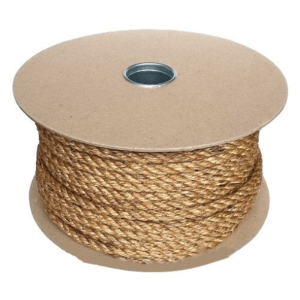
Manila is a natural rope fibre, produced from the abacá plant.
Although it’s not actually made from hemp, it is often referred to as ‘manila hemp’ due to its hemp-like properties. For example, it demonstrates excellent levels of strength, flexibility, durability and resistance to UV. However, it absorbs water – shrinking (and sinking) when wet. And if left outdoors for long periods, it is susceptible to the elements and will rot and break down over time.
Best for: Indoors and outdoors
Common uses: Gardening and landscaping, decking, battle ropes, rope fenders.
Be inspired: Manila rope – improve your upper body strength, 3 reasons to shop with us for decking and fencing rope, Garden rope fence ideas, How to make a rope fender
Jute and Sisal Ropes and Twines
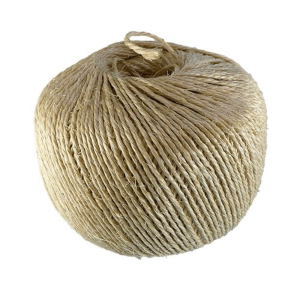
Jute and sisal are both derived from plants (Corchorus Capsularis and Agave Sisalana, respectively).
Not only are they inherently strong, they’re resilient to wear and tear and resistant to sunlight. They demonstrate little to no stretching. Thanks to their rough texture, they have excellent knot-ability. And the best bit? They’re 100% sustainable, biodegradable and compostable. Please note much of the jute rope we sell has a synthetic rope core for added strength.
Best for: Indoors and outdoors
Common uses: Arts and crafts, agriculture and farming, gardening.
Be inspired: Jute string – a popular choice for gardens, How to make a rope plant hanger, 5 Christmas craft ideas using rope, Have a ball with kokedama, How to make a teepee
Polypropylene rope
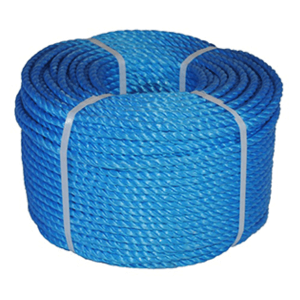
Polypropylene is a great all-rounder.
As a synthetic rope material, it has a number of useful properties. For example, it doesn’t absorb liquid and floats on water. It demonstrates good resistance to UV and abrasion and is rot-proof. It’s strong and hard-wearing (despite being lightweight) and has a high melting point of 165˚C.
Available in a variety of sizes and colours, it’s suitable for a range of domestic and business purposes.
Best for: Outdoors
Common uses: Construction and groundworks, cable pulling, tying down, marine applications and yachting, utilities and industry, crafts and hobbies, forestry.
Be inspired: How to season wood, Choosing the best rope for mooring a boat, Aquatic engineering with our blue polypropylene rope, The advantages of polypropylene rope
Synthetic hemp
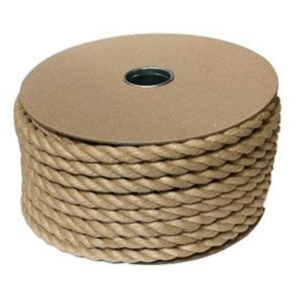
Technically speaking, synthetic hemp isn’t a rope material in its own right – as it’s made from spun polypropylene. But it does differ from polypropylene in one key way: it looks like a natural hemp rope.
Offering the best of both worlds – synthetic hemp boasts the rustic appearance of a rope that’s made from plant fibres, yet has all the benefits of being manufactured from a synthetic material.
It doesn’t shrink or swell when wet. It’s soft-to-touch yet easy to grip. And most importantly, it’s strong, durable and weather-resistant – allowing it to be kept outside for long periods.
Best for: Outdoors
Common uses: Decking, outdoor handrails, on ships and boats, children’s play apparatus (rope swings, rope ladders, climbing ropes etc.), fencing, garden seats.
Be inspired: How to make a rope handrail, Create a jungle gym for the kids, How to make a wooden swing, 5 rope decoration ideas for the garden, Fence design ideas, Decking – the no1 home project, Create a garden playground for the kids, How to make a rope ladder
Nylon rope
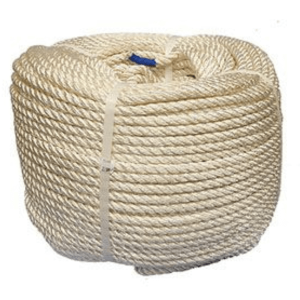
Nylon is one of the most favoured rope materials currently available.
Made from polyamide fibres, it boasts a range of useful properties – including exceptional industrial-grade strength, very good UV and abrasion resistance and a 215˚C melting point. It’s also highly flexible and shock absorbent, capable of stretching by up to 20% and returning to its original length.
However, it does soak up water quite quickly – compromising its structure – and takes a while to dry.
Best for: Outdoors
Common uses: Lifting, towing, mooring, winching, water-based applications.
Be inspired: Nylon vs polyester rope – what’s the difference?
Polyester rope
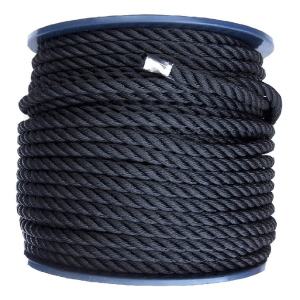
Polyester shares many of the same properties as nylon.
For example, it’s strong, low-stretch and durable. It demonstrates excellent resistance to UV rays, abrasion, rot and chemicals, and has a high melting point of 260˚C. But it has one major difference – although it will sink, it exhibits low water absorption and is much better suited to marine-based applications.
As a result of its qualities, polyester is often used as the cover for other rope fibres.
Best for: Outdoors
Common uses: Flagpoles, pulleys, tie-downs, sailing and boating, dinghy control lines.
Be inspired: Charity work in Uganda helped with our ropes, Choosing the best rope for mooring a boat, How to moor a boat with the correct mooring ropes
HMPE rope
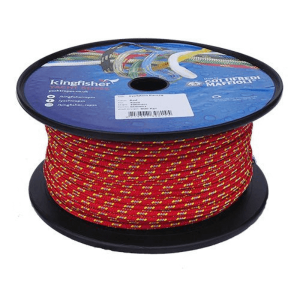
A reel of Dyneema rope – Dyneema is a brand of HMPE rope
HMPE (High Modulus Polyethylene) ropes are high-performance ropes, with a diverse range of useful properties. First and foremost, they have an incredible strength-to-weight ratio (at least eight times stronger than hardened steel).
They also demonstrate good UV resistance and excellent abrasion resistance. They have a high melting point of 135-145˚C and they don’t absorb water – making them ideal for marine use.
However, they’re very static, with low levels of elongation. And as the fibres are self-lubricating, HMPE isn’t recommended if you need a rope that will hold knots successfully.
Best for: Outdoors
Common uses: Industrial winching, towing, cranes and pulley systems, deep-water installations, marine applications, fishing lines, water sports, mountaineering, arboriculture.
Be inspired: HMPE – in focus
Still not sure which is the best type of rope for you?
Additional information on the different types of rope and rope materials available can be found in our ‘Help Choosing Rope’ section. So before making a purchase, it’s worth taking a look. Think about what the rope will be used for and remember to always read the product description very carefully.
Our RopeFinder tool should also help to point you in the right direction.
But if you’re still struggling to decide, or have any questions about rope fibres, please don’t hesitate to get in touch. We’re friendly, knowledgeable and always at the other end of the phone!

